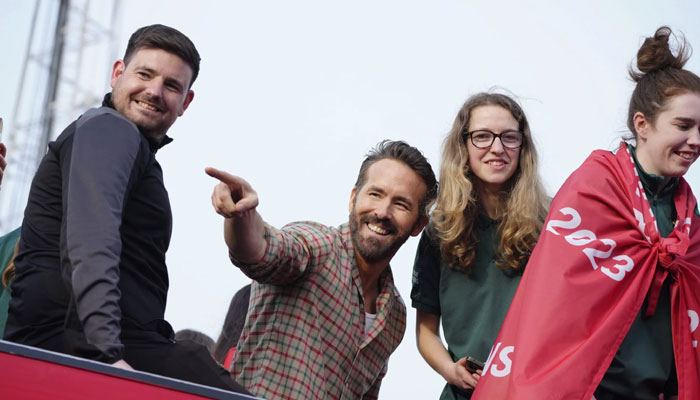Save Log in , register or subscribe to save articles for later. Save articles for later Add articles to your saved list and come back to them any time. Got it Normal text size Larger text size Very large text size In 2003, while he was working at a production company that made television commercials, aspiring director Fede Alvarez won a promotional trip to Los Angeles to attend the premiere of X-Men 2 at Hollywood’s Chinese Theatre.
He took his best mate, and the two lads had the trip of a lifetime. “We thought, that’s it, life has peaked right there,” Alvarez says. But that momentary connection to the heart of Hollywood inspired him, and Alvarez returned home, quit his job directing commercials and learnt how to write a script.

His 2009 short film, Ataque de Pánico , brought him back to LA where he signed his first movie deal, and the studio threw in tickets to a premiere that night: Ninja Assassin , back at the Chinese Theatre. Cailee Spaeny as Rain Carradine and David Jonsson as Andy in Alien: Romulus. Flash forward 15 years, to earlier this week, and Alvarez was again standing in the Chinese Theatre, for the third time in his life, this time at the front of the auditorium speaking to a packed, invitation-only audience at the world premiere of Alien: Romulus , his $US80 million half-sequel, half-prequel homage to Ridley Scott’s grotesque, thrilling Alien franchise.
“How did I get here?” Alvarez asked. The answer is a journey that took the 46-year-old Montevideo, Uruguay-born filmmaker from Ataque de Pánico , the darling of the Buenos Aires horror and science fiction film festival Rojo Sangre, to the heart of the Hollywood horror mainstream, with a stopover in 2013 directing the hilariously gory Evil Dead . And if you’re wondering, he quips: “ Ninja Assassin was not as good as X-Men 2 .
” Archie Renaux (left), director Fede Álvarez, Cailee Spaeny and Spike Fearn at the London gala screening of Alien: Romulus. Credit: Antony Jones/Getty Images for The Walt Disney Company Limited In taking on the director’s mantle of Alien: Romulus , Alvarez joins a pantheon that includes the franchise’s original director, Ridley Scott, James Cameron (who directed its first sequel, Aliens ), David Fincher ( Alien 3 ) and Jean-Pierre Jeunet ( Alien Resurrection ). What makes him such a compelling choice as director, however, is that before taking on the job, he was a huge fan of the original films.
Advertisement In that sense, he is following in the footsteps of creative leaders like J.J. Abrams who turned Star Wars fandom into control of the franchise, Russell T.
Davies and Steven Moffat, who were Doctor Who fans before show-running the series, and Terry Matalas, who went from Star Trek superfan to producer of one of the finest outings of the modern franchise, the nostalgic, epic final season of Picard . As a filmmaker, Alvarez says, “Sometimes the audience has a better idea of what you’ve done than yourself. It has happened to me with my own movies.
I live in a world where my movies don’t really exist. I have never really seen them the way you have. That happens to all of us.
The 1979 cast of Alien (from left): John Hurt as Kane; Veronica Cartwright as Lambert; Tom Skerritt as Dallas; Yaphet Kotto as Carter; Sigourney Weaver as Ripley; Harry Dean Stanton as Brett; and Ian Holm as Ash. “Ridley Scott lives in a world where Ridley Scott’s movies don’t exist, really; he never knows what it was to sit down, watch Gladiator , not knowing what’s going to happen. So in a way, sometimes, the artist is the last person to know what they’ve really done.
“Being the mad people who took over the asylum, in a way, it’s really that we are sometimes more objective than the filmmakers themselves that make the original movie. The task is to take it back, and try to create the same emotions that the original movie made.” Xenomorph in a scene from Alien: Romulus.
Director Fede Álvarez intentionally copied the retro styling of the original Alien. Alien: Romulus is the seventh Alien film in production order (but not story order), and stars Cailee Spaeny ( Priscilla , Civil War ) as Rain, a young miner who escapes a Weyland-Yutani-owned colony and leads a team of escapees on a salvage mission that, predictably, goes alien-up. Advertisement Tackling Alien: Romulus was artistically complex.
Set between the two original films, 1979’s Alien and 1986’s Aliens , the film has to defer to the “future” as those two films styled it decades ago, but also remain faithful to the techniques of filmmaking of that era, to establish a visual consistency within the expanded universe of the Alien franchise. John Hurt in the original Alien film’s most iconic - and grotesque - scene. That means remaining true to the alien design of Swiss painter and sculptor H.
R. Giger, who worked on the original Alien , but also using the same real-world special effects of previous films. It was not a problem for Alvarez, who prefers real effects to CGI.
“I am a lover of more than film, I love the craft of filmmaking,” Alvarez says. “That’s what I fell in love with as a kid. And for most of us that make movies, that’s the truth.
So I’ve always been obsessed with the techniques.” Speaking to Scott and Cameron before taking on Romulus , they told him the same thing: “You have to do everything yourself, you want [the film] to be special, there’s no version of this where you just hire the right people, look back, relax, and they’ll do it for you,” Alvarez says. “You have to really be there all the time, on the floor with everybody else and push it and push it to really do it right.
” Alvarez said Aliens , in particular, became a touchstone for his preparation for Romulus . He drilled deeply into its production history, poring over the fine print. “People think Aliens was a big budget movie, but it wasn’t,” Alvarez says.
(A quick check with Wikipedia confirms the budget was a staggeringly miniscule $US18.5 million.) “Everybody said, Cameron was painting things himself, building the props, [he was] involved with every aspect of it.
Xenomorph and Cailee Spaeny in Alien: Romulus. Director Fede Alvarez says the aliens shouldn’t automatically be thought of as evil. Credit: 20th Century Studios “It was just the passion of a filmmaker, that he really wanted to do the best he could with the money he had, that that movie became what it was.
“That was the intention here. That was the approach and that is something that doesn’t happen every day, particularly in bigger Hollywood movies.” Advertisement At the heart of any Alien story is the now-iconic creature, which represents the lurking horror of the “in space no one can hear you scream”-inspired nightmares of our childhoods.
Creatively, as the story’s monster, it also connects Alvarez with one of his greatest influences, the modern master of horror filmmaking, Guillermo del Toro. “He always sees the monster as the good guy, which, ironically, when you watch Alien , if it was a Guillermo del Toro movie, the creature would seem to be the victim,” Alvarez says. “He’s not trying to kill anybody.
They’re trying to chase him. He’s born right there, and they’re trying to get him. Sigourney Weaver in the original 1979 film Alien, directed by Ridley Scott.
Credit: Fox “So if you watch it, with the right sensitivity, you feel sorry for the creature. Right? Even in our movie, when the creature is born, it looks for the scent of the mother, but the mother is dead. In a del Toro movie, that would’ve been the whole thing, to really show the tragedy of the existence of this creature.
” Loading Alien: Romulus owes much to its heritage, and as well as a number of cinematic homages, to the original films. Alvarez acknowledges consciously, trying to mimic the very slow, almost glacial reveal of the original alien, a creative choice that turned Alien into one of the most significant (and properly horrifying) films of all time. “There’s going to be a whole [segment of the] audience that go to watch this movie that have not seen any of them, and I want to make sure [we] deliver the creature to them in a way that was done in the best movies, in a very slow burn,” Alvarez says.
Advertisement “That is what makes it terrifying. I remember my first impression of the creature in Alien, and it looked to me like a sort of black dragon made of chains descending from the ceiling. What I wanted to do here was something that evokes that.
You have to really try to channel those nightmarish images.” IN SPACE NO ONE CAN READ A CALENDAR: MAKING SENSE OF THE ALIEN TIMELINE At the heart of the Alien franchise sits the Weyland-Yutani Corporation, a large British-Japanese multinational conglomerate founded in the year 2099 by the merger of Weyland Corp and the Yutani Corporation. Its primary businesses are the manufacture of biomechanical “synthetic” androids, starship components and computers.
The company also sits at the heart of the conspiracy that holds the Alien narrative together: driven, depending on the film you’re watching, to either obtain a living sample of the seemingly unstoppable alien “Xenomorph XX121”, or to knowingly impregnate human crew members with the embryos of the creatures. Sigourney Weaver and Winona Ryder in Alien Resurrection. Exactly which bit of the alien – its acid blood, its relentless homicidal tendencies or its willingness to annihilate Weyland-Yutani’s ships, crews and colonies – appeals to their balance sheet or their corporate governance policy is unclear.
But they have been part of a slowly unfurling narrative jigsaw that connects the original Alien in 1979, to the new film, Alien: Romulus . Alien: Earth (2025), set in 2092: A new television series for the US streaming platform Hulu, from writer/director Noah Hawley, planned for release next year. This is the first piece of the story jigsaw.
It is the keystone to the Alien story in that it will finally tell the story of Weyland-Yutani, and perhaps resolve some of the franchise’s enduring mysteries. Advertisement Prometheus (2012) and Alien: Covenant (2017), set in 2093-2104: Two films, directed by Ridley Scott, which serve as Alien prequels. The first follows an Earth space expedition as it travels to a distant planet to find remnants of humanity’s forerunners, a species known as “the Engineers”, while the second completes the link to the Alien story, in which the crew, returning from that mission, encounter a xenomorph crash site on a distant planet.
Alien (1979), set in 2122: The original Alien film, directed by Ridley Scott, in which an industrial ship, the Nostromo, encounters a ship, of Engineer-design, containing a hive of alien eggs, which has crashed on a lifeless planetoid. One of the crew, Kane (John Hurt), is impregnated with the alien embryo, which (after “chest bursting”, in the film’s now iconic scene) hunts and kills the crew. Ellen Ripley (Sigourney Weaver) is the only survivor.
Alien director Ridley Scott (middle) on the set of 1979 classic. Credit: Fox Alien: Romulus (2024), set in 2142: The newest film in the Alien franchise is set roughly 20 years after the original Alien, and some 40 years before its original sequel, Aliens. In it, a group of young mine workers from a Weyland-Yutani-owned colony escape to what they think is a passing starship wreck, but it turns out to be a derelict space station, which has been wrecked after a deep-space recovery mission has gone terribly wrong.
Aliens (1986), set in 2179: Directed by James Cameron, Aliens picks up the story after Ripley’s drift home in hypersleep, during which time the planetoid LV-426 (the setting of the original Alien ) has been terraformed and colonised. But when Ripley tries to warn Weyland-Yutani, nobody believes her story about the Nostromo’s alien encounter. Right on cue, contact with the colony is lost and Ripley returns with a marine team, including Corporal Hicks (Michael Biehn), to find aliens – plural, hence the title – on the planet.
Sigourney Weaver in Alien 3. Alien 3 (1992), set in 2180: Set in the aftermath of Aliens, David Fincher’s Aliens 3 picks up the story as the survivors are transported to Earth on the spaceship Sulaco, but an emergency landing strands Ripley on the prison colony Fiorina 161, and an alien embryo escapes into the prison facility, sending the colony into chaos, and leaving Ripley to deal with the realisation that she is the carrier of a future xenomoprh queen. Alien Resurrection (1997), set in 2379: Two centuries after Alien 3 , the starship Auriga is the site of a cloning operation, which has produced a clone of Ripley – known as Ripley-8 – as well as the queen embryo she was carrying at the time of her death.
Fighting the clock, Ripley-8 and a team of mercenaries must stop the aliens before the Auriga reaches Earth. Alien: Romulus is now in cinemas. Find out the next TV, streaming series and movies to add to your must-sees.
Get The Watchlist delivered every Thursday ..



















